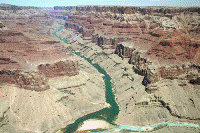United States Geological Survey

Geochemistry of Sulfate Minerals: A Tribute to Robert O. Rye
Date of this Version
2005
Abstract
Big Rock Candy Mountain is a prominent center of variegated altered volcanic rocks in west-central Utah. It consists of the eroded remnants of a hypogene alunite deposit that, at ~21 Ma, replaced intermediate-composition lava flows. The alunite formed in steam-heated conditions above the upwelling limb of a convection cell that was one of at least six spaced at 3- to 4- km intervals around the margin of a monzonite stock. Big Rock Candy Mountain is horizontally zoned outward from an alunite core to respective kaolinite, dickite, and propylite envelopes. The altered rocks are also vertically zoned from a lower pyrite– propylite assemblage upward through assemblages successively dominated by hypogene alunite, jarosite, and hematite, to a flooded silica cap. This hydrothermal assemblage is undergoing natural destruction in a steep canyon downcut by the Sevier River in Marysvale Canyon. Integrated geological, mineralogical, spectroscopic remote sensing using AVIRIS data, Ar radiometric, and stable isotopic studies trace the hypogene origin and supergene destruction of the deposit and permit distinction of primary (hydrothermal) and secondary (weathering) processes. This destruction has led to the formation of widespread supergene gypsum in cross-cutting fractures and as surficial crusts, and to natrojarosite, that gives the mountain its buff coloration along ridges facing the canyon. A small spring, Lemonade Spring, with a pH of 2.6 and containing Ca, Mg, Si, Al, Fe, Mn, Cl, and SO4, also occurs near the bottom of the canyon. The 40Ar/39Ar age (21.32±0.07 Ma) of the alunite is similar to that for other replacement alunites at Marysvale. However, the age spectrum contains evidence of a 6.6-Ma thermal event that can be related to the tectonic activity responsible for the uplift that led to the downcutting of Big Rock Candy Mountain by the Sevier River. This ~6.6 Ma event also is present in the age spectrum of supergene natrojarosite forming today, and probably dates the beginning of supergene alteration at Big Rock Candy Mountain. The δ34S value (11.9%◦) of alunite is similar to those for replacement alunite from other deposits in the Marysvale volcanic field. The δ34S values of natrojarosite (0.7%◦ to ‒1.2%◦)


Comments
Published in Chemical Geology 215 (2005)